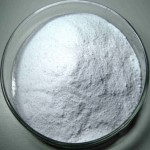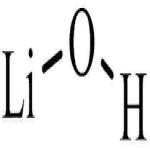Lithium Carbonate BP Ph Eur USP Grade & Lithium Hydroxide Monohydrate and Anhydrous USP Grade Suppliers Exporters, Manufacturers
Lithium Carbonate
CAS Number: 554-13-2, BP Ph Eur USP Grade Suppliers Exporters, Manufacturers
Please visit Safety Data Sheet of Lithium Carbonate Manufacturers.
Specifications of Lithium Carbonate USP Grade
Li2CO3 --- 73.89
Carbonic acid, dilithium salt.
Dilithium carbonate -- CAS 554-13-2
Lithium Carbonate contains not less than 99.0 percent of Li2CO3, calculated on the dried basis.
Identification:
A: It effervesces upon the addition of an acid, yielding a colorless gas which, when passed into calcium hydroxide, immediately causes a white precipitate to form.
B: When moistened with hydrochloric acid, it imparts an intense crimson color to a nonluminous flame.
Reaction: A saturated solution is alkaline to litmus.
Loss on drying: Dry it at 200 for 4 hours: it loses not more than 1.0% of its weight.
Insoluble substances: Transfer 10 g to a 250-mL beaker, add 50 mL of water, then add slowly 50 mL of 6 N hydrochloric acid. Cover with a watch glass, and boil the solution for 1 hour. Filter the solution through a dried, tared filtering crucible fitted with a glass-fiber filter disk, using suction. Wash the filter with hot water until the last washing is free from chloride when tested with. Dry the crucible in an oven at 110 for 1 hour: the weight of the residue is not more than 0.02% of the weight of Lithium Carbonate taken.
Chloride: To 500 mg of it add 1.2 mL of nitric acid, dilute with water to 50 mL, and add 1 mL of silver nitrate any turbidity formed is not greater than that produced in a similarly treated control solution containing 0.50 mL of 0.020 N hydrochloric acid (0.07%).
Sulfate: Dissolve 1.0 g in 10 mL of 3 N hydrochloric acid, dilute with water to 40 mL, and add 1 mL of barium chloride. Prepare a standard solution of equal volume containing 1.0 mL of 0.020 N sulfuric acid, 1 mL of 3 N hydrochloric acid, and 1 mL of barium chloride. The turbidity produced in the test solution, after 3 minutes, is not greater than that produced in the standard solution (0.1%).
Aluminum and iron: Dissolve 500 mg in 10 mL of water by the dropwise addition, with agitation, of hydrochloric acid. Boil the solution, then cool it, and to 5 mL of the solution add 6 N ammonium hydroxide until the reaction is alkaline: no turbidity or precipitate is observed.
Calcium: Suspend 5.0 g in 50 mL of water, and add a slight excess of 3 N hydrochloric acid. Boil the clear solution to expel carbon dioxide, add 5 mL of ammonium oxalate, render alkaline with 6 N ammonium hydroxide, and allow to stand for 4 hours. Filter through a filtering crucible, and wash with warm water until the last washing yields no turbidity with calcium chloride. Place the crucible in a beaker, cover it with water, add 3 mL of sulfuric acid, heat to 70 , and titrate with 0.10 N potassium permanganate to a pale pink color that persists for 30 seconds. Not more than 3.76 mL of 0.10 N potassium permanganate is consumed (0.15%).
Sodium: the sodium limit is 0.1%.
Heavy metals: the limit is 0.002%.
Specifications of Lithium Carbonate BP Ph Eur Grade
Ph Eur
Li2CO3 --- 73.9 --- CAS 554-13-2
DEFINITION
Content: 98.5 per cent to 100.5 per cent.
CHARACTERS
Appearance: White or almost white powder.
Solubility: Slightly soluble in water, practically insoluble in ethanol (96 per cent).
IDENTIFICATION
A. When moistened with hydrochloric acid, it gives a red colour to a non-luminous flame.
B. Dissolve 0.2 g in 1 ml of hydrochloric acid. Evaporate to dryness on a water-bath. The residue dissolves in 3 ml of ethanol (96 per cent).
C. It gives the reaction of carbonates.
TESTS
Solution S: Suspend 10.0 g in 30 ml of distilled water and dissolve by the addition of 22 ml of nitric acid. Add dilute sodium hydroxide solution until the solution is neutral and dilute to 100 ml with distilled water.
Appearance of solution: Solution S is clear and colourless.
Chlorides: Maximum 200 ppm.
Sulphates: Maximum 200 ppm.
Arsenic: Maximum 2 ppm, determined on 0.5 g.
Calcium: Maximum 200 ppm.
Iron: Maximum 20 ppm.
Magnesium: Maximum 150 ppm.
Potassium: Maximum 300 ppm.
Sodium: Maximum 300 ppm.
Please visit Hazard Statement of Lithium Carbonate BP Ph Eur USP Grade Manufacturers.
Lithium Hydroxide
CAS Number: 1310-66-3 monohydrate or 1310-65-2 anhydrous, USP Grade Suppliers Exporters, Manufacturers

Please visit Safety Data Sheet of Lithium Hydroxide Manufacturers.
Specifications of Lithium Hydroxide USP Grade:
LiOH-H2O --- 41.96
LiOH --- 23.95
Lithium hydroxide monohydrate CAS 1310-66-3.
Lithium hydroxide Anhydrous CAS 1310-65-2.
DEFINITION
Lithium Hydroxide contains NLT 98.0% and NMT 102.0% of lithium hydroxide (LiOH), calculated on the anhydrous basis.
A. When moistened with hydrochloric acid, it imparts an intense crimson color to a nonluminous flame.
Chloride and Sulfate, Sulfate:
Sample: 2.0 g
Acceptance criteria: It shows no more sulfate than corresponds to 1.0 mL of 0.020 N sulfuric acid (0.05%).
Calcium:
Sample solution: Dissolve 3.33 g in 50 mL of 3 N hydrochloric acid. Boil the clear solution to expel carbon dioxide, add 5 mL of ammonium oxalate, render alkaline with 6 N ammonium hydroxide, and allow to stand for 4 h. Pass through a filtering crucible, and wash with warm water until the last washing yields no turbidity with calcium chloride. Place the crucible in a beaker, cover it with water, add 3 mL of sulfuric acid, and heat to 70C.
Analysis: Titrate the Sample solution with 0.10 N potassium permanganate to a pale pink color that persists for 30 s.
Acceptance criteria: NMT 3.34 mL of 0.10 N potassium permanganate is consumed (0.20%).
Carbonate:
[Note: While pipeting and during the subsequent titrations, keep the contents of the flasks blanketed with a stream of carbon dioxide-free air.]
Analysis: To the flask containing the completed Final titration obtained in the Assay, add 1 drop of methyl orange TS. Titrate with 0.1 N hydrochloric acid VS until a persistent orange color is produced and no undissolved barium carbonate remains. Perform a blank titration to determine the volume of 0.1 N hydrochloric acid consumed in going from the phenolphthalein endpoint to the methyl orange endpoint. To 100 mL of carbon dioxide-free water in a 250-mL conical flask, add 3 drops of the Sample solution from the Assay, 20 mL of 1 N barium chloride, and 3 drops of phenolphthalein TS. Allow to stand for 2 min. Titrate this solution with 0.1 N hydrochloric acid. At the discharge of the pink color of the indicator, add 1 drop of methyl orange TS, and titrate with 0.1 N hydrochloric acid VS until a persistent orange color is produced.
Acceptance criteria: The titration shows no more carbon dioxide than corresponds to 1.5 mL of 0.10 N hydrochloric acid (0.7%).
Lithium Content: To pass the test by Flame photometry.
Acceptance criteria: 28.1%-29.9% on the anhydrous basis.
Water Determination:
Analysis: Dry at 135C at a pressure of NMT 5 mm of mercury for 1 h.
Acceptance criteria: 41.0%-43.5%
Packaging and Storage: Preserve in tight containers.

Please visit Hazard Statement of Lithium Hydroxide USP Grade Manufacturers.
Lithium Carbonate BP Ph Eur USP Grade CAS Number 554-13-2 & Lithium Hydroxide USP Grade CAS Number 1310-66-3 monohydrate or 1310-65-2 anhydrous Supplier Exporter, Manufacturer:
Annie Chemie P Ltd
Mumbai 4000010, INDIA
With Agents and offices in UAE, USA, Europe.
e-mail: info@anniechemie.com
Copyright and Usual Disclaimer is Applicable.
May 31, 2025
Exporters to USA, Canada, UK, Europe, UAE, Nigeria, Algeria, Turkey, Mexico, Brazil, Chile, Argentina, Australia, Dubai etc.
Perfection is made up of small things and that is a big thing.
